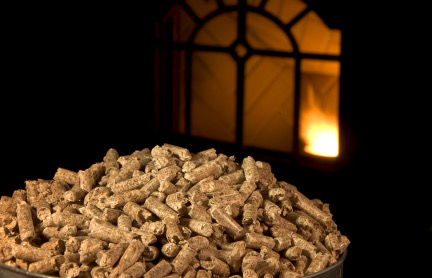Biomass fuel comes in a variety of forms including biodiesel, alcohol and waste materials but the one typically used in our homes is wood. Logs, chips or pellets are burned in stoves or boilers, heating internal spaces directly or providing hot water for distribution and heating throughout the home.

Rising energy prices have led to a considerable uptake in these systems and you’ll probably know someone who’s had a wood burning stove fitted in the last couple of years.
In addition to renewable heat generation and cost savings, wood burning stoves often provide a pleasant focal point to a room and there is definitely something primordial about getting cosy around a wood burning flame.
Sustainability
Biomass is derived from recently grown organic matter as opposed to ancient organic matter that has formed fuels like oil or coal over millions of years.
The fuel is considered carbon neutral because the carbon dioxide released when the wood is burned is offset by the amount it absorbed during its lifetime through photosynthesis.
Waste timber otherwise destined for landfill is also processed and used for wood fuel, which prevents adding to our already overstretched landfill resources.
Types of Biomass Fuel Heater
There are two main ways to utilise biomass fuel in your home:
1. Stand Alone Heater
Logs, chips or pellets are burnt in a wood burning stove generating direct heat for one space within the home. Some of these appliances are capable of incorporating automatic fuel feeders and back boilers for hot water.
2. Biomass Boiler
This replaces a gas or oil fired boiler as part of the home’s central heating system. Wood is burned to heat water, which is then distributed throughout the house for hot water and space heating. Again, logs can be used but it is common to use pellets or chips, which can be loaded into a hopper and automatically fed into the boiler as required.
Costs
Contact local installers for a more accurate estimate for an installation suited to your specific needs.
Considerations
It’s all very well installing a system but make sure you’ve got access to a good supply of fuel. If you are considering a pellet or chip auto feed system, check for local fuel suppliers before proceeding too far. Don’t forget that you’ll also need somewhere dry to store a generous supply.
Following the smoggy days of the industrial revolution, The Clean Air Act led to the introduction of smoke control zones around the country. If you live in one of these areas then you may be restricted on the type of appliance you can have. Contact your local Council to find out if you are in a control zone and find out what the restrictions and exemptions are by visiting DEFRA’s Smoke Control Areas: The Rules.
Planning Permission
As with many microgeneration systems, the installation of biomass fuel systems fall within permitted development rights.
This is however subject to “the flue being no more than 1m above the ridge line of the highest part of the roof and not facing onto and visible from a highway in a conservation area or World Heritage Site.” (Department for Communites and Local Government, 2009).
If you’re in any doubt speak to your local planning department for advice.
Building Regulations
The building regulations apply to the installation of any type of fuel burning appliance so they’ll apply here. Contact your local authority building control for more information on meeting the requirements.
If your property is no more than 3 storeys and you employ a HETAS (Heating Equipment Testing and Approval Scheme) registered installer then there is no need to use building control.
We recommend giving them a call anyway just to be on the safe side.
More Information
More information on biomass fuel for microgeneration is available from:
- The Department for Energy and Climate Change
- The Energy Saving Trust.
- The Microgeneration Certification Scheme (MCS) – For manufacturers and installers.
- HETAS (Heating Equipment Testing and Approval Scheme) – solid fuel appliance installers approved by building control.
A Biomass fuel appliance can produce carbon neutral heat and hot water for your home. A wood burning stove can enhance a room and there is nothing quite like an open flame on a cold evening.
Return to Eco Homes
Return to Home Page from Biomass Fuel
